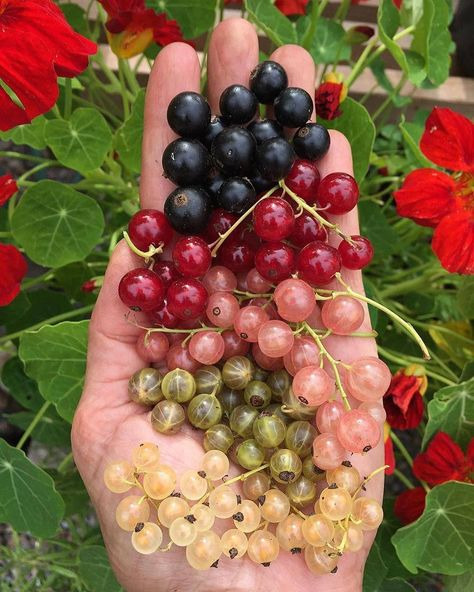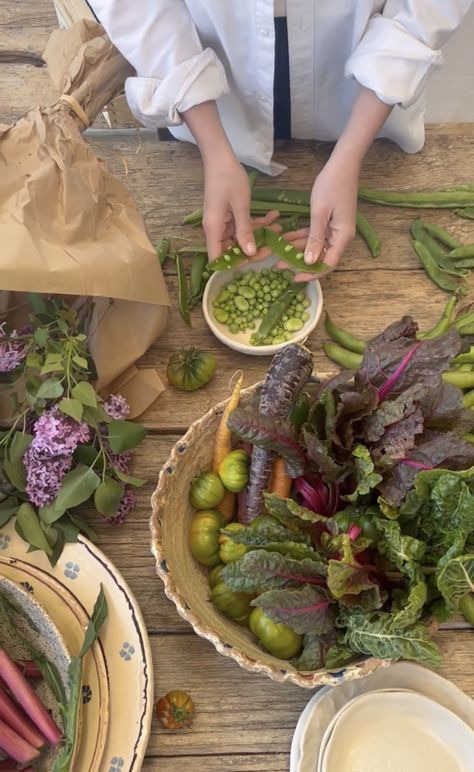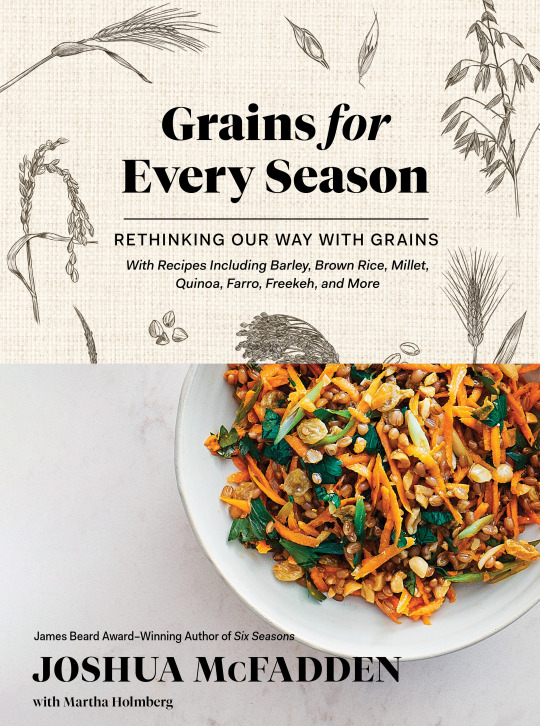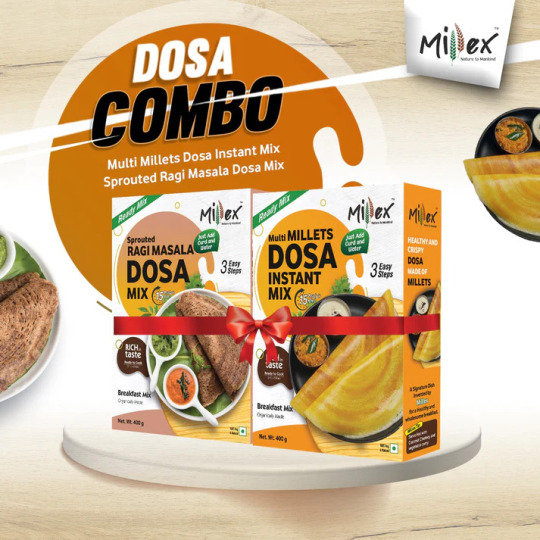#how to cook millet rice
Explore tagged Tumblr posts
Text
#millets vs rice nutrition#millet#millets#millet benefits#millet nutrition#nutrition values of millets#nutrition#barnyard millet nutrition#nutritional value of millet#nutritions#millets vs rice#indian millets#millets health benefits#indian millets benefits#millet recipes#how to cook millet rice#millet health benefits#nutrition facts#millets for diabetes#indian millets types#nutritional properties of millets#millet diet
0 notes
Text
what is with the health-food fixation on Ancient Grains? as far as I can tell, there's some notion that they're, like, Healthy and Rich in Nutrients and Exotic and Untainted by Mass Production. and that they're things like Farro and Quinoa and Bulgur and Amaranth and Millet and Sorghum.
one Healthline article opens with
"Ancient grains tend to be less processed than modern grains, like corn and wheat. Because of this, ancient grains have more vitamin, mineral, and fiber content. Including ancient grains in your diet may come with health benefits."
Its 12 "ancient grains" are amaranth, millet, kamut, sorghum, teff, freekeh, farro, barley, quinoa, bulgur, rye, and fonio.
But like. Freekeh, farro, bulgur, and kamut are wheat. They are wheat!!
Corn was domesticated around 9,000 years ago! it's ancient! Rice sometime around 10,000 years ago! Wheat maybe 11,000 or more! Quinoa is a few thousand years old, amaranth maybe 5,000, barley around 11,000, teff maybe 6,000. They're all old enough to have long histories of domestication and cultivation, but corn and wheat and rice are decidedly ancient.
And decidedly nutritious! people have been cooking with them for millennia because they're good! they vary in how much of any given nutrient they provide - rice and amaranth have less than wheat and quinoa, say - but like. specifically on that last one. quinoa is marketed as this high protein grain that vegetarians and vegans should fall all over themselves for but cooked wheat grains (farro bulgur etc) may actually have more protein than quinoa. and just normal-ass flour and bread and pasta! have protein! a fair amount!! cooked pasta has about as much protein as quinoa! not to say that the way grains or processed has no impact or that all grains have similar properties (they don't), just that "ancient grains" are not better across-the-board than their equally-ancient-but-not-marketed-thus counterparts
i mean first and foremost it's a marketing ploy, a health food scam, a way for companies to market their Virtuous Anciente Farro over our Modern Vulgar Wheat, whatever. but it's way less coherent than I realized - fully just an incorrect portrayal on all counts. And it's got a strong flavor of both an exoticizing racism and a... regular... racism beneath everything else, and that's all twisted on itself too...
note 1 that I am no expert on the history of grains + this all is my stream-of-consciousness wikipedia-ing reaction to initial dabbling in the history of said grains, not a well-backed or well-researched view
anyway I had ancient grains (regular-ass pasta) with ancient vegetables (tomatoes, peppers) and ancient legumes (beans) and an ancient drink (tea) for lunch and i feel pretty cool about the history of domesticated crops hbu
59 notes
·
View notes
Text


NANBAN RYŌRI & NAMASU NO BU (SHOGUN MEAL, 17th c.)
Having recently returned from my first ever trip to Japan, I was super excited to try my hand at this next Tasting History recipe: Nanban Ryōri and Namasu No Bu, elements that, together, make up an example of a Shogun meal from the 17th century. The recipe for Nanban Ryōri comes from The Southern Barbarians' Cookbook, which was a cookbook written in the 17th century (or earlier) in Japan to describe Portuguese and Spanish dishes which were entering Japanese cuisine at that time, making it unique among premodern culinary writings in Japan. "Nanban" culture entered Japan along with Christianity before enforcement of the national seclusion policy of the Tokugawa Shogunate in the early 17th century, and at this time, many quintessentially Portuguese dishes and foods became part of Japanese dishes and food culture (tempura also stems from this influence!). This shogun meal includes two different preparations of white rice, one plain and one seasoned with a mixture of Japanese and European flavors, like dashi and cloves, showing how ingredients from both Japanese and European food cultures were used together to form a complete meal. The typical meal for a shogun or samurai wasn’t much different from what everyone else ate. There was usually soup, fish, and pickled vegetables. The rice you ate would depend on your class: polished (white) rice for the elite, brown rice for the wealthy, and millet for everyone else. The quality of some of the ingredients could vary depending on your status, but the basic components were the same. See Max’s video on how to make this dish here or see the ingredients and process at the end of this post, sourced from his website.
My experience making it:
As usual, I halved the recipe. Because I couldn't find gobo (burdock root) in any grocery stores near me, I omitted it entirely. The rest I sourced at my local Asian supermarket. I made a couple other small changes to the ingredients, like using powdered ginger instead of minced ginger, and using saffron to colour the stock instead of the dried gardenia fruits, since I also couldn't find those anywhere. For the bowl of white rice to accompany the dish, I used the same Baldo rice from the Acem Pilavi recipe last week. If you're wondering what I seasoned this rice with, it is my newly-discovered favourite Japanese seasoning, which I brought back from our trip to Japan: Yukari (shiso rice seasoning). Not sure if it is historically of the time, but it is so tasty!
First, for the namasu dish: I started off by chopping the daikon into strips and dissolving the sugar into the rice vinegar. I heated the vinegar and sugar up on the stove and added in the kombu, the dried, salted seaweed rehydrating nicely. My scatter-brained self having already somehow missed several of the instructions (salting the daikon and squeezing out its juices, namely), I strained the rice vinegar into a container and added the daikon strips. They were just submerged, as planned. At this point, I realized my mistakes, so I haphazardly scattered a pinch of salt on top of the submerged daikon in an effort to fix things. I tossed it in the fridge to chill, and I re-read the instructions once more. It was then I found out I was meant to chill the pickled mixture for 24 hours. It was already approaching dinner time, and I was not going to wait until tomorrow to make this meal, so I accepted that my pickled daikon might only get four hours to marinate. Always pre-read the recipe - my lesson to take away!
Next, for the nanban ryōri: I dissolved the dashi powder into a pot of water, then added two large chicken legs. I brought it up to a boil, then turned the heat down so that it was just lightly simmering. I skimmed the foam off as it arose, and simmered it for 2.5 hours, which gave me time to cook the Baldo rice, prepare the polished rice (washing and mixing it with ginger, garlic, pepper, clove, and green onion), and chop the pickled daikon (not the one I made, but the store-bought one). When the chicken and broth had finished cooking and simmering, I removed the chicken onto a cutting board and strained the broth, just with a normal strainer since I don't have a cheesecloth. I then added some saffron powder to 'yellow' the broth. I didn't bother letting it steep for 30 minutes, because I think the saffron dissolved pretty quickly. I added the polished rice to a pot and then added all of the broth, which was a little more than Max suggested, but I figured I could always cook it a little longer if needed. I closed the lid and let it steam for 20 minutes, stirring occasionally, then took it off the heat to steam 10 more minutes. During this time, removed the chicken bones and sliced the meat - it was perfectly tender and completely cooked through. It basically fell off the bone! I also used this time to take the vinegared daikon out of the fridge and remove the daikon from the vinegar. Once the rice was finished cooking, I began plating everything. This took awhile, because I had my heart set on using our new Japanese crockery and chopsticks! I seasoned the Baldo rice with the yukari seasoning, arranged the chicken on top of the yellow rice, chopped a few green onions to put on top, and shook a few black sesame seeds on the chicken. For a garnish on top of the namasu, I put a little of the kombu seaweed. Altogether, the meal looked wonderful plated up - I could easily see this being served in Japan!
My experience tasting it:
My chopsticks reached first for the namasu, the daikon strips. I was worried they hadn't had long enough to marinate in the vinegar, but, boy, was I wrong. They were pretty sour, and just a tiny bit salty. If anything, I think they might have sat in the vinegar too long! I was glad I hadn't let them sit in there for 24 hours; I think that would be overkill. Despite the sourness, they did taste alright, though. Next, in order to compare, I tried the store-bought pickled daikon, the yellow-ish one. This one tasted much sweeter, definitely more palatable and to my liking. One thing I love about daikon is the satisfying crunch! Finally, I decided to dig into the star of the show, the nanban ryōri: the chicken was super tender, both the white and red meat, and went with the rice beneath it really well! The green onion and black sesame seeds added a nice extra flavour. I must say, however, the rice did taste strongly of saffron, and I think I may have altered the dish too much in the direction of European flavours instead of the Eastern flavours the dried gardenia fruits may have added. The rice somehow tasted almost medieval European - which I don't think is how this dish is meant to taste according to the recipe and how Max described it. Still, it was yummy, and my husband and I ate all of it. Lastly, I had some of the Baldo rice with the yukari seasoning. The seasoning added a lovely saltiness to the rice - can't go wrong with yukari, in my opinion! Overall, I was happy with how the meal tasted, and so was my husband. I will say that the nanban ryōri did not taste very Japanese, especially in terms of flavours, but I suppose that makes sense, seeing as this dish is specifically showing how to make recipes brought by the Portuguese. The daikon, in both forms, was delicate in texture and strong in flavour, and went nicely with the Baldo rice as a side. Of course, the preparation and cook time for this shogun meal was very long, and while we enjoyed eating this meal, I wouldn't say it is so tasty that it is worth the long cook time. As a result, I probably will not make it again, but I will definitely buy that pickled daikon again! I really look forward to try making more Japanese recipes going forward, provided I can source the right ingredients. If you end up making this dish, if you liked it, or if you changed anything from the original recipe, do let me know!
Links to harder-to-find ingredients:
Kombu
Dashi
Dried Gardenia Fruit
Nanban Ryōri original recipe (17th c.)
Sourced from Nanban Ryōrisho (The Southern Barbarian’s Cookbook) (17th c.).
Nanban Ryōri Boil a chicken to make a broth. Color the stock with gardenia. Add black pepper, a bit of clove, ginger, garlic, and green onion to well-polished rice. Cook this in the stock. Place pieces of the chicken over the rice.
Modern Recipe
Based on the recipe from Nanban Ryōrisho (The Southern Barbarian’s Cookbook) (17th c.) and Max Miller’s version in his Tasting History video.
Ingredients:
Namasu no Bu (Lightly Pickled Vegetables)
1 1/2 cups (350 ml) rice vinegar
1/3 cup (65 g) sugar
Small piece of kombu* (dried seaweed)
1 large daikon (Japanese radish)
2 pieces of gobo (burdock root)
2 teaspoons salt
Nanban Ryōri (Chicken with Seasoned Rice)
2 tablespoons dashi powder**
3 quarts (3 L) cold water
2 lbs (1 kg) mixed chicken pieces with bones, or a whole chicken cut up
4 dried gardenia fruits***
1 1/2 cups (300 g) Japanese white rice, or other short grain rice
A large pinch of black pepper
A regular pinch of ground clove
1/2 teaspoon minced garlic
1/2 teaspoon minced ginger
2 teaspoons chopped green onion
Chopped green onion, for garnish
Black sesame seeds, for garnish
Cooked plain white rice, for serving
Pickled daikon, for serving
*Kombu is dried seaweed with tons of umami. It has a natural, white, salty powder on it, which is where most of the flavour is, so don't wash it off.
**Dashi is an umami-rich soup stock that is a staple in Japanese cooking. It's usually made with kombu (dried kelp) and katsuobushi (dried bonito flakes). You can make your own, or you can buy dashi powder or packets (like dashi tea bags) that you prepare with water.
***These dried fruits come from a type of gardenia that is native to Southern China. It's used to dye all kinds of things yellow, like food, clothes, and paper.
Method:
For the namasu: Mix the vinegar and sugar in a pot. Add the kombu and heat to a gentle boil, making sure all the sugar dissolves. Take it off the heat and let it cool completely.
Peel the daikon and gobo. Chop both into thin sticks, about 2 inches long.
Mix the daikon and gobo in a bowl and sprinkle them with the salt and toss to make sure the salt is evenly distributed. Let it rest for 5 minutes.
After the 5 minutes, squeeze out as much liquid as you can from the vegetables. Take the kombu out of the vinegar (save it for later), and pour the vinegar over the daikon and gobo. Ideally, you want the vegetables to be completely submerged. You can make it in a dish, but an easy way to do this is to put everything in a plastic bag and squeeze out the air. Either way, let it sit in the fridge for about 24 hours.
For the nanban ryōri: Stir the dashi powder into the water in a large pot. Add the chicken to the dashi and water and set the pot over medium-high heat. Bring it to a boil and skim off any foam and scum from the surface. Reduce the heat to low and simmer for 30 to 40 minutes, or until the meat is cooked through. If you’re using chicken breast, keep an eye on it and take it out once it’s cooked, but leave the rest of the pieces that have bones in there.
Continue to simmer for another 2 hours. It should reduce to about 1 liter of liquid. Once it’s reduced, take it off the heat and strain it through some cheesecloth.
Break up the dried gardenia fruits and put them in the strained broth. Steep for 30 minutes, then strain them out. The broth should be a nice yellow.
Rinse the rice well, until the water is clear. Mix the pepper, clove, garlic, ginger, and green onion with the rice in a pot or rice cooker. Add 1 1/2 cups (350 ml) of the broth to the rice. Cook in a rice cooker or simmer it on the stove, covered, for 20 minutes, then turn the heat off and leave the lid on to let it steam for another 10 minutes.
After the rice has cooked, dish it up onto a plate. Slice some of the chicken and arrange it on top. Garnish with chopped green onion and black sesame seeds. Put some of the namasu into a small bowl. Chop up the kombu that you saved from the vinegar and put a little on top of the namasu for garnish.
Serve the dishes forth with a bowl of white rice and some sliced pickled daikon.
#max miller#tasting history#tasting history with max miller#cooking#historical cooking#meat#chicken#rice#daikon#namasu no bu#so don't wash it off.#like food#clothes#and paper#yellow.#Nanban Ryōri#Nanban Ryōrisho#The Southern Barbarian's Cookbook#japanese recipes#japan#17th century#asia#shogun#pickling
2 notes
·
View notes
Text
[Kanto] [Johto] [Hoenn] [Sinnoh] [Unova] [Kalos] [Alola] [Galar] [Hisui] [Champs] [Paldea] [Paldea2] [Paldea3] [Teams] [Misc.]
Ya know who else I've totally neglected in this series of posts? The Battle Frontier bosses.

Anabel's name is LILA[リラ] from Lilac, hence her color scheme. That one's super straight forward.
Spencer's name was UKON[ウコン] from ukon[鬱金] the name for tumeric, a type of ginger root that is very popular traditional chinese medicine.
Noland's name was DATURA[ダツラ] from the genus of poisonous flowers in the Nightshade family, as well as other such charming common names as Devil's Trumpet, Hell's Bells, and Devil's Weed. They are all not only extremely poisonous but psychoactive
Brandon's name was JINDAI[ジンダイ] a neat pun as the common Japanese name of this cactus, jindai[神代], means "god time" as in "age of the gods/myth" in other words, "ancient," which of course lends to his role as Ruins Maniac/Pyramid King.
Tucker's name is HEATH[ヒース] which funny enough means he shares a namesake with Erika, and with Heath, aka HEATHER, Briar's ancestor that wrote the violet/scarlet book.
Greta's name is KOGOMI[コゴミ] from kogomi[屈] the Japanese name for the fiddlehead fern, used in cooking. They have a super distinctive curled shape which is where she gets her hair.
and then Lucy's name is AZAMI[アザミ] as in Azami[薊]: "thistle," appropriate for her prickly demeanor.

Technically I already did Darach's once, but I'll go over it again here. His name is KOKURAN[コクラン] as in kokuran[黒蘭], lit. "Black Orchid" and as a play on that Caitlin is actually named Cattleya[カトレア] from the Catelleya genus of orchids. His ancestor Anthe was named Sharon[シャロン] in reference to the Rose of Sharon, which is actually a common name of a few unrelated flowers, including the national flower of South Korea. (Oddly she seems to bear absolutely no relation to the Orchid theme between Kokuran and Cattleya. )
Argenta's original name was KEITO[ケイト] from keitou[鶏頭] the Japanese name for the Silver Cockscomb, which has very obvious color associations that lend to her design. Also the Silver Cockscomb's scientific name is the Celosia argenta, which is where they got her English name.
Palmer's name is KURUTSUGU[クロツグ] after kurutsugu[桄榔] the Kaong Sugar palm
Thorton's name was NEJIKI[ネジキ] from nejiki[捩木] the Japanese name of the Anyaar/Angeri(Lyonia ovalifolia). They have thee adorable little white bell flowers.
and finally for this batch, it's Dahlia who was in fact just named DAHLIA[ダリア]. For the image i picked a yellow Spider Dahlia specifically since it seemed to match her color scheme and hair

Oh and just to round out this little batch of extras, Barry's name is actually JUN[ジュン] from Junichi Masuda, game director of the core Pokemon series. It's a play on Gary's name being SHIGERU[シゲル], after Shigeru Miyamoto. But sadly it has nothing to do with his dad's name.
While I'm here...

Cheryl's name was MOMI[モミ] from momi[籾] which is a word that refers to unhulled rice specifically. Unrelated to her ancestor Wasabi's name.
Marley's name is MAI[マイ] from mai[米], which is just the word for "Rice" as a food staple, so depending on context it can implicitly mean when hulled, because the alternative would be momi, but it does also generally to the crop and even the food industry. (Ironically Mai in Hisui was actually named YONE[ヨネ] which is an alternate reading of the same kanji for "rice" [米], yet they named her Mai in English, Marley's actual Japanese name...)
Go figure, Buck's name is in fact BAKU[バク] and it's the Japanese word baku[麦] for Wheat or Barley. By sheer coincidence it is how Japanese phoneticizes "Buck" but it does not actually refer to Buck Wheat. Also he has nothing to do with his brother, nor their ancestor's names.
Mira's name is MIRU[ミル] from "Millet." It's also where her little hairtie design comes from.
and finally, Riley's name is GEN[ゲン] from genmai[玄米] the name for brown rice, which is a kind of earthier more nutritious rice.

So oddly, there is a concept in Chinese agriculture and cooking called Wu Gu[五穀]: "The Five Grains" that refers to the 5 staple crops of Chinese agriculture dating back to ancient times, and several far et cultures have their own variations on this... but despite the obvious grain theming the 5 stat specialist trainers don't actually match any specific version of the 5 Grains?? It definitely feels like that was the intended reference, yet it sort of falls apart in the specifics... maybe just a disagreement on what made fora good name or not?
Oh and as for a few other oddball ancestors...

Sabi, Mai, and Zisu I've all technically covered before in one form or another but the quick overview is that Sabi was named WASABI[ワサビ], YONE we mentioned above, and Zisu was named PERILLA[ペリーラ], after the same type of redleaf mint that Flint, aka OBA[オーバ], was named after.
Pesselle's name is KINE[キネ] from kine[杵]: "(mortar &)pestel" which is both a cute play on Millet and on her role as head of the medical division and the grinding of medicinal herbs.
and Riley's ancestor Rye is actually named HAKU[ハク] as in haku[白]"white"but sensibly a reference to hakumai[白米]:"White rice" in parallel to Gen's gen[玄] also reading literally as "Black/Dark" when referring to "brown rice."
#pokemon#pokemeta i guess#pokemon emerald#pokemon dppt#pokemon hgss#pokemon legends arceus#hisui#sinnoh#hoenn#johto#battle frontier
14 notes
·
View notes
Text
Exploring Special Diets: Gluten-Free, Keto, and Other Healthy Eating Plans
As awareness of health and wellness grows, more people are turning to special diets to meet specific health needs, manage conditions, or pursue better lifestyle choices. Popular dietary plans like gluten-free, keto, and other specialized diets are not just trends—they represent meaningful ways to optimize nutrition and address medical concerns. However, cooking for these diets can feel complex, especially for those unfamiliar with the requirements. This article will explore the essentials of cooking for special diets, the benefits of each, and how to create delicious, healthy meals that adhere to these unique dietary guidelines.
The Gluten-Free Diet: Essential for Some, Beneficial for Many
Adhering to a gluten-free diet is essential for the health and well-being of individuals with celiac disease, gluten intolerance, or wheat allergies. Celiac disease is an autoimmune condition in which consuming gluten—a protein found in wheat, barley, and rye—triggers an immune response that damages the lining of the small intestine. Even those without celiac disease but with gluten sensitivity may experience bloating, fatigue, and digestive discomfort when consuming gluten.
Cooking gluten-free meals involves more than just removing gluten from the diet; it requires careful substitutions to maintain taste, texture, and nutrition. Luckily, gluten-free alternatives have become more widely available, including products like gluten-free bread, pasta, and flours made from rice, almonds, or coconut.
A simple way to begin gluten-free cooking is by focusing on naturally gluten-free foods, such as vegetables, fruits, meats, fish, and dairy. For example, grilled chicken with roasted vegetables and quinoa is a naturally gluten-free meal. When baking, gluten-free flour like almond or rice flour can replace traditional wheat flour. However, these flours may require adjustments to liquid ratios in recipes since they behave differently than wheat flour.
Using naturally gluten-free grains such as quinoa, buckwheat, or millet also ensures that you can create satisfying, hearty meals without compromising taste. A significant consideration for gluten-free cooking is preventing cross-contamination, especially in kitchens where gluten-containing foods are also prepared.
The Keto Diet: High-Fat, Low-Carb for Energy and Weight Loss
The ketogenic (keto) diet focuses on high-fat, moderate-protein, and low-carbohydrate intake, designed to force the body into a metabolic state called ketosis. In ketosis, the body burns fat for energy rather than carbohydrates, leading to fat loss and, for many, better overall health markers. Originally developed to treat epilepsy, the keto diet has become a popular choice for weight loss and managing conditions like type 2 diabetes.
The cornerstone of the keto diet is limiting carbs—usually to under 50 grams per day—while consuming plenty of healthy fats like avocado, nuts, seeds, and oils. Protein intake comes from sources like fatty fish, eggs, and meats, and vegetables are chosen from low-carb options such as leafy greens, broccoli, and cauliflower.
Cooking for the keto diet involves finding replacements for traditionally carb-heavy foods, such as bread, pasta, and potatoes. Cauliflower rice, zoodles (zucchini noodles), and lettuce wraps are great low-carb swaps that still provide volume and flavor to meals. For example, a stir-fry made with chicken, cauliflower rice, and low-carb vegetables offers a satisfying, keto-friendly alternative to a typical rice-based dish.
One critical challenge with keto cooking is creating sweet treats without traditional sugars. Fortunately, keto-friendly sweeteners like stevia, monk fruit, and erythritol allow for the creation of low-carb desserts such as cheesecake, fat bombs, or keto-friendly chocolate treats.
Paleo Diet: Back to Basics with Whole Foods
The paleo diet, inspired by the eating habits of our hunter-gatherer ancestors, promotes consuming whole, unprocessed foods while avoiding grains, dairy, and refined sugars. The idea behind this diet is that our bodies are better adapted to the foods available to early humans, and modern processed foods contribute to various health issues, including inflammation, obesity, and chronic diseases.
Paleo cooking focuses on whole foods like meat, fish, eggs, vegetables, fruits, nuts, and seeds. Processed foods, legumes, grains, and dairy are eliminated, making the paleo diet rich in nutrients while also helping reduce the intake of inflammatory ingredients. Cooking paleo meals involves using alternative ingredients such as almond flour, coconut flour, and sweeteners like honey or maple syrup.
For example, a paleo breakfast might consist of scrambled eggs with spinach and avocado, while a dinner could include grilled salmon with roasted sweet potatoes and a side salad. Paleo baking involves using grain-free flour, such as almond or coconut flour, to create treats like muffins, pancakes, or bread.
Vegan and Plant-Based Diets: Focusing on Plants for Health and Sustainability
Vegan and plant-based diets focus on whole, plant-derived foods. Veganism excludes all animal products, including meat, dairy, and eggs. A plant-based diet is more flexible, allowing some animal products but still prioritizing plant foods. These diets are praised for their potential health benefits, such as reducing the risk of heart disease, and their positive environmental impact.
Cooking vegan or plant-based meals requires creativity to replace animal proteins with plant-based alternatives. Staples include legumes (such as beans, lentils, and chickpeas), tofu, tempeh, and whole grains. Nuts, seeds, and oils provide healthy fats, while leafy greens, fruits, and a variety of vegetables ensure a balanced nutrient intake.
One challenge in vegan cooking is ensuring adequate intake of nutrients such as vitamin B12, iron, and protein, which are typically found in animal products. Fortified plant-based milk, nutritional yeast, and a wide variety of legumes and grains can help meet these nutritional needs.
Vegan baking often uses flaxseed or chia seed as egg replacements, while aquafaba (the liquid from a can of chickpeas) can mimic egg whites in recipes. Desserts can be made using ingredients like almond milk, coconut oil, and natural sweeteners to create indulgent treats like vegan brownies or ice cream.
Tips for Cooking Special Diets
Ingredient Substitutions: Finding creative substitutes for restricted ingredients is critical. Almond flour and coconut flour are versatile replacements for wheat flour, and cauliflower can replace rice or potatoes in many dishes.
Meal Prep: Planning and preparing meals ahead of time ensures that healthy, diet-compliant meals are always available. Batch cooking and freezing meals can make adhering to a particular diet more manageable.
Experimenting with Recipes: Don’t be afraid to try new recipes or modify existing ones to fit your dietary needs. Many classic dishes can be adapted using alternative ingredients, ensuring you don’t feel deprived.
Cooking for special diets—whether gluten-free, keto, paleo, or plant-based—may seem challenging at first, but with the right approach, it becomes a rewarding and sustainable way to eat. These diets offer numerous benefits, from managing medical conditions to promoting overall wellness, and with the abundance of available alternatives and resources, following them has never been easier. By embracing dietary changes and finding joy in experimenting with new ingredients, anyone can cook healthy, delicious meals tailored to their unique needs.
6 notes
·
View notes
Text
A Matter of Chance - 8
Aditha thought he’s been feeling a lot of guilt lately. His presence only causing problems for her, her injury and so on....
He had just calmed her and laid her down to rest. He admired her peaceful slumbering form when guilt struck him again.
This time though, it was because he was shamelessly admiring an injured patient. Her face was still as soft and glowing as before. If anything, passing years only refined her.
Her sweet eyes whose expressions were only understood by him.
The pouty full lips that he’d earned to caress since boyhood.
Her legs, that he touched to check for injuries, had grown stronger with hardwork while her skin remained soft.
This day seems to have messed his morals more than any war.
----------------------------------------------------------------------------------------------------------------------
“Anna (older brother), how can you take her side? How could you leave your own sister and support that orphan?” Kundavai raged.
Aditha immediately froze. The retort he had prepared wasn't uttered. He could only think about comforting her now
He very well understood how Kundavai’s last word would impact Nandini.
Soon enough, the person in question immediately fled out of the courtyard with him hot on her heels.
Her feet carried her across the temple pond, the grasslands and into the woods. The woods were her only refuge – even her beloved Krishna temple she had to share sometimes.
She slumped against the thick tree bark and waited to catch her breath. She sat down and rested her head against the bark as her tears silently flowed.
“Why did mother leave me? Was I truly so great a burden?”
“Why would God punish me thus?”
“Why did they tell me about my birth?”
As she bitterly perused these questions, she felt a gentle arm rest upon her own and pat her knee.
She didn't want apologies on behalf of his sister or cajoling about how she's better off than others. The boy seemed to understand.
He moved closer to make her lean on him as she wept.
---------------
Nandini woke up again, feeling just as sore as before. Every attempt to move only hurt her muscles more. Yet she felt a little less miserable, as warm hands lovingly supported her efforts.
Her groggy eyes adjusted to the lantern light and saw a smiling face. “Ah well, better this one than some stranger” she thought.
“Thank goodness you've risen. I’ve made supper” Aditha proudly said, pointing towards bowls of wild berries, millets cooked with spices and tamarind, charred vegetables and a pitcher full of buttermilk.
She blinked twice at the feast before her. She was reminded of the dinners she shared with her foster family before their exile.
Her mind quickly readied a taunt about princes and their cooking knowledge, but she swallowed it as her stomach grumbled.
Aditha placed a plate below her hands and poured water over them. They both sat on the floor next to each other. They closed their eyes in prayer before they tucked in.
Nandini was famished and couldn't be bothered to hide her appetite.
“Huh! I certainly don't eat like the elegant noblewomen his family wishes for him to marry- if it scares him - then so be it! he was never worth the trouble” she tried to convince herself.
Aditha gleefully relished the sight of her tucking in and inwardly praised himself.
“You seem to like what I’ve made. I’m glad” he said cheekily
“Yes” was her only answer before she continued munching happily.
“Remember the tamarind rice served as prasadam when we were younger? It was your favourite, right?”
This elicited a smile from Nandini “Yes, I worked all day in the temple. I’d wake up at the break of dawn, bathe in the temple pond before praying and doing chores at the temple throughout the day and retire after dinner. My only respite was in the evenings, where I’d eat tamarind rice by the pond” she reminisced fondly.
Aditha was relieved at the change in mood “Pious though you were, you’d still use your influence to sneak me some extras of the prasadam! Only because I was your dearest friend, right?” he teased
She huffed impatiently “you were one of my few friends who didn’t judge my birth. Besides, I only felt sorry for you! You’d always look so weary after your sword fighting lesson”
Aditha knew the depth of her affection but didn’t want to push it. A mere word from him and the priests would’ve delivered pots of prasadam to the palace!
“Well, they say happy patients recover quicker and what better joy than good food” he said and served more onto her plantain leaf, receiving a glare in return.
Nandini was unnerved by how peaceful she felt. Aching body, sprained ankle and back, mental unrest due to seeing a former lover- all seemed to be little hurdles now. And it was the very same man whose presence she hated until this noon, that was easing her circumstance.
He had cared for her the whole day, completely devoting himself to her comfort and even stopped his romantic overtures.
Aditha gently moved her onto the mattress and changed her bandages. He gently applied a new layer of herbal paste before tying the knot.
------------
It's fluff o' clock coz I felt like it 🙈
@vidhurvrika @nspwriteups @thatacademic @thelekhikawrites @whippersnappersbookworm @hollogramhallucination @chiyaanvikram @love-ps1ff @ragkee @kovaipaavai @nashibirne @babayagahunt @dr-scribbler @yehsahihai @nirmohi-premika @vibishalakshman @sowlspace
And all else !
#ponniyin selvan#aditha karikalan#nandhini#ponniyin selvan fanfiction#nandini x aditha#nandini x karikalan
27 notes
·
View notes
Text
Why Cleaner Diets (Plant Based, Whole Foods, Raw Vegan, etc) Make People Sick & How to Easefully Adopt a Healthier Diet🦋 | Holistic Leveling Up!




Heard of people breaking out, unbalancing their hormones, getting fatigued, losing hair, developing gut issues, or becoming prone to colds having made a perfectly nutritious upgrade to their diet? (BTW I don't mean anything low-carb or high-fat. These don't meet the body's actual needs and lack fiber. They are not wise to practice unless you want fatigue and constipation).
Apart from the psychological and social difficulties of adhering to a healthier diet, there are also the physiological effects. Many people will claim that fully adequate diets made them sick and it must just not work from them because "everybody's body is different." The actual reason for this is that the body's natural detoxification pathways become less encumbered, and especially if drastic switches are made, the rates of cleansing can be too intense (simply eating more nourishing foods over junk foods is cleansing as it supports detoxification rather than inhibiting it). Most people are unaware that we have to take such permanent lifestyle transformations like this gradually, especially if we come from a history of illness or heavy junk food eating. I always recommend using the transitory principles of the Mucusless Diet Healing System (devised by Prof. Arnold Ehret), no matter how you are changing your diet. So, if you are looking to nourish your body as it deserves, seeking to remove processed foods, towards a primarily-fully whole foods, plant-based, home-cooked, mucusless, and/or frugivorous diet, all of the following applies.
Step 1: Understand that everything in nature makes permanent changes with transitory phases. For example, the life cycles of animals and growth of plants. Ehret says that "Nature's mills grind sure but slow." Overnight, cold turkey methods are not reliably effective because they work against nature. What we eat affects us chemically several times per day. To make a change in our foods is to change the chemical environment within us. (Making continual, progressive transformations to diet & lifestyle can look like this).
Step 2: Eliminate the worst mucus-forming foods first. Pus-forming foods (animal based products) are the most obstructing as they decompose in the digestive tract. They create the most powerful cravings and impediments to healing, since they have gummy residues and are fiber-less, which causes them to struggle to be fully eliminated from the digestive tract. If you are already off of animal ingredients, reduce/eliminate rice, gluten pasta, and other sticky grains from your diet. Opt for more coarse, sprouted, and gluten-free grains, like wild rice, millet, and buckwheat (until you transition away from them if that is your goal).
Step 3: Increase your intake of fruits and vegetables, especially the virtually fat-free and starch-free [or starch-free once cooked] ones because they are mucusless (for example, avocados, potatoes, and cassava are mucus-forming). These will help you to adjust to more nourishing meals because they are the best at developing a diverse & balanced gut microbiome. Base your meals around ripe fruits and well-grown vegetables. Have a predominantly or all-fruit breakfast (eg. baked peaches, spiced and stewed apples, smoothie, or fruit salad). Have a large delicious salad as (the bulk of) your dinner. Or follow the principles in the Transition Diet sections of the Mucusless Diet Healing System for most effective results. (For sensitive tummies or those unused to a fiber-rich lifestyle, introduce fiber gradually, focusing on fruit fibers, fresh cold-pressed juices, and smoothies). BTW eat enough! It can take a while to get used to feeling full up on plants. You may feel like you're eating tons, but it's all good :)
Step 4: Assist your body in its detoxification with holistically healthy habits. The most important of these is to undergo colon hydrotherapy. I know it seems strange from some, but since the gut is the foundation to our health and we have a long history in eating so many unsuitable foods don't eliminate completely (as we see with the prevalence of colon cancers and digestive problems), giving that additional cleaning to the intestines is as important as brushing your teeth. After having a natural bowel movement, it is suggested to do a lemon and distilled water enema (once a day to once a week, for best results). Enemas and colonics can also help relieve symptoms caused by lymphatic congestion, like headaches, colds, edema, bloating, toothaches, etc. Other holistic habits to assist cleansing: sweating, exercise & stretching, sauna, sunbathing (start with short periods in sun), salt/herb baths, fresh juice in the morning, breathwork, meditation & mindfulness (reduce stress), laugh more, get fresh air, aromatherapy, herbal teas, rational fasting protocols (begin first with mastering intermittent fasting and proper break-fast), naturally laxative food herbs (prunes, beets, chia seeds, psyllium husk, spinach, dates, etc), sound healing (relaxation), dry brushing, lymphatic massage, use of non-toxic products, etc. Try not to practice extreme things which can "shock" the body into intense detox phases. For example, cold plunging can be unhealthy for people with unregulated nervous systems.
Step 5: Kick out unhealthy cravings naturally. Replace them with whole food plant based, homemade alternatives. Or if you absolutely can not shake them, continue with your regular menus and eat it after your dinner salad. When your cravings are strong, be sure to continue with your colon hydrotherapy routine. Soon, your body will become cleaner and more sensitive to the foods (you will not want to experience their effects) and/or the craving will go away. Your cravings will tend to become healthier, for things like beans and your favorite fruit, rather than pizza and deep fried things.
Step 6: Keep things exciting. People often think eating healthier means more boring meals. Pfft. That's the exact opposite. There's so much intrigue in preparing high quality meals for yourself. And then...Your palate for all the rich plant flavors will expand too. I encourage you to try new fruits, vegetables, and herbs. Try some different beans, nuts, seeds, and grains too (if your goal isn't to be mucusless). Go to farmer's markets, wholesalers, ethnic markets & aisles, big box supermarkets, online specialty organic retailers (for bulk ingredients like dried fruit, herbs, or spices), and even clean convenience store items (eg. I've found unpasteurized tropical fruit pulps for smoothies, with no added ingredients). Research about the cuisines and herbal traditions from your own cultures and others. Often, the meals of the poor citizens were the most nourishing all along. You will discover more flavor combination ideas for salads, dips, sauces, spice blends, and teas. Rediscover that appreciation for simplicity and refreshing flavor in your meals.
Step 7: Enjoy the transition to doing bigger and better and more nourishing things for your body. You will easily become an expert in your own body and empowered to take your health into your own hands via these methods. Sometimes, it will feel arduous to get into the routine of meal prepping and grocery shopping -- but you're absolutely worth that effort. Understand the position you are in. You are making permanent epigenetic changes to the genetic codes you have been passed down. This is a gift that will impact the children you may have, the friends you make, the people you meet, and the generations to come. When we heal ourselves, we are not just healing our individual selves. It is about helping our world which has become so sidetracked with destructive habits & refortifying the influence of the nurturing instinct.
BEFORE YOU GO✨
Here's some extra guidance from 20+ year Mucusless Diet Healing Practitioner and Arnold Ehret expert, Prof. Spira in his article "Art of Transition":
"Although Ehret was a fruitarian thinker who asserted that a mono-fruit diet is the best for humans, he by no means suggested that people in our pathological condition can achieve such a level immediately without a considerable amount of dietary transition and PRACTICE of the Mucusless Diet. Many health seekers hear of fruitarianism and aspire to just jump right in without an extended period of transition...
Ehret’s healing system is not immediate raw-foodism, mono-fruit diet, or irrational extended water fasting, but a SYSTEM that coordinates the use of raw and cooked mucusless and mucuslean menus—in concert with short and long term periods of RATIONAL FASTING—to safety and effectively transition off of all mucus-forming foods. Yes, raw-fruit-mono diet is identified to be supreme, yet we must earn this level of excellence.
Not over night, but only after having paid reparations for the wrong that we, and our relatives, have done to our bodies all the days of our life. The key to sustaining the diet on a long term basis is the mastery of the Art of Transition. Whether it is through intuition, intellect, spiritual awakening, or scientific understanding, emancipating oneself from eating pus and mucus must be a top priority for those interested in physiological freedom.
And after generations of mucus-eating ancestors, it will simply not happen overnight. There is no shortcut around the transition. As Brother Air often says, 'you can be on the transition diet for more than 30 years if you need to be, but you will still be here.'”
May all beings be blissful💚😊🌼
#txt#true nourishment#holistic leveling up#clean eating#self love#wellness journey#self care#green juice girl#that girl#mindful consumption#slow living#soft living#holistic health#food centric herbalism#vegan#vegetarian#wfpb#whole food plant based#fitblr#healthy eating#raw vegan#fruitarian#frugivore#fasting#mucusless diet healing system#raw til 4#gastronomy#nutrition#detox#sidewalkchemistry
13 notes
·
View notes
Text




Seasonal Cookbook Recommendations
Farmhouse Rules by Nancy Fuller
Nancy Fuller believes in bringing family together around the table, sharing stories and table manners. Her philosophy is to feed others with delicious, simple meals from the heart. Her straight-shooter approach to cooking will take the hassle out of dinner preparation. Every recipe helps readers to make healthy, authentic cooking their daily standard and shows readers how satisfying freshly cooked comfort food can be.
Festive Holiday Recipes by Addie Gundry
In this cookbook, Food Network star Addie Gundry offers easy, delightful holiday recipes for everyone looking for that last minute recipe for entertaining. From appetizers for holiday and New Year's Eve entertaining, like Caramelized Onion Tartlets, to recipes for The Best Roast Turkey and all your favorite sides and pies, this book is a home cook's trusty sous chef for easy and elegant entertaining throughout the holiday season.
Gather at Home by Monika Hibbs
In this cookbook, Monika Hibbs shares her favourite relaxed and easy ways to make your everyday moments and seasonal celebrations special. Use Monika's collection of over 100 simple recipes, crafts, and do-it-yourself projects, conveniently divided by season, to turn your Friday family games night, Mother's Day brunch, holiday dinner, or outdoor evening barbecue into something memorable.
Grains for Every Season by Joshua McFadden
Joshua McFadden is back as he applies his maximalist approach to flavor and texture to cooking with grains. This cookbook’s 200 recipes are organized into chapters by grain type, unlocking information on where each one comes from, how to prepare it, and why the author can’t live without it. This volume will change the way we cook with barley, brown rice, buckwheat, corn, millet, oats, quinoa, rye, wheat, and wild rice.
#cookbooks#seasonal cooking#nonfiction#reading recommendations#reading recs#book recommendations#book recs#library books#tbr#tbr pile#to read#booklr#book tumblr#book blog#library blog#readers advisory
2 notes
·
View notes
Text
WIP Wednesday: Tender
Thank you to the anon who sends me reminder asks about WIP Wednesday - it is nice to know that someone is looking forward to these!☺️
This week, I'm continuing work on Tender, which is the obligatory LWJ-visits-the-Burial-Mounds fic, described in this post, which features the first scene of the fic. In response to another ask, I also recently posted this Wen Qing scene from the same WIP, so I thought for today's WIP Wednesday, I'd post the scene that goes between those two! Despite the subject matter (content warning for mentions of sex work, not between the main characters), this fic is significantly softer than Concord, I promise. I hope you enjoy!
The next morning, Lan Wangji makes his purchases in town and embarks on the path to and through the Burial Mounds.
With every step, his horror grows – he is constantly aware of the seethe of resentful energy, the thick smog of angry death, coiling against his skin and in his lungs. How can Wei Ying bear to live here? How can anyone?
But he makes his way past the wards—Wei Ying was correct that they are nothing more than a difficult puzzle to unravel, although they would pose a serious obstacle for a lesser cultivator—and as he approaches the palace, he is surprised to find the miasma of rage and bitter death fading.
By the time he steps into a sort of a clearing, with rows of crops off to one side, the choking stench of decay is almost entirely gone.
Wei Ying is there to greet him, smiling broadly and flanked by Wen Qing and an older woman who Lan Wangji assumes to be the “Wen-popo” Wei Ying had mentioned last night. Behind them are others, mostly women and old men. They look afraid.
Of him.
Lan Wangji bows deeply and projects his voice when he says, “Wei Ying, it is good to see you again. Wen-guniang, thank you for welcoming this one to your home.” He bows once more specifically to the older woman and introduces himself. From behind her leg, a small child peeks, wide-eyed.
When he straightens up, the other Wen refugees look somewhat less frightened. He hopes that his next actions will make it even clearer that he has no hostile intent.
“Wen-guniang, Wen-popo—” for so she had told him to address her, “—this cultivator has brought gifts for his hosts. May he present them to you?”
“Lan Zhan!” Wei Ying cries in protest.
Wen Qing ignores him and steps forward. Quietly, she says, “It is unnecessary. But we are not too proud to accept Hanguang-jun’s generosity. This Wen Qing thanks you.”
Lan Wangji nods and begins to unpack his qiankun bags: rice and millet, salt and rope, cooking oil and lamp oil. Items clearly intended for the entire settlement, not for one man.
And, at the end, the sweets, and a few toys that Lan Wangji had been unable to resist, which he delivers directly to the child, A-Yuan. A-Yuan is so overwhelmed with joy that he cries, causing Lan Wangji to panic and thereby making him a source of great amusement for the other Wens. Nothing, he suspects, is less threatening than a grown man rendered witless by a sobbing child. It is worth the embarrassment.
As the Wens disperse to store his gifts in the appropriate places, Wei Ying approaches him. He is still smiling. But there is a touch of wariness to it. “Rich-gege,” he says, teasing. “So generous.”
Lan Wangji shakes his head. It is shameful, how little these staples cost him. He has never been so excruciatingly conscious of his own wealth.
“Lan Zhan.” Wei Ying’s gaze is steady. “I know what you’re trying to do.”
“Thank you for explaining the community’s needs,” Lan Wangji replies, blandly. “It was helpful in selecting appropriate gifts for my hosts.”
“Helpful.”
“Mn.”
“Well. I’m always helpful.” Wei Ying’s eyes are still fixed on Lan Wangji’s face.
Then he blinks, startled, as A-Yuan barrels into his leg. “Aiyo, little radish, are you still crying?” he asks the boy, ruffling his hair.
“I never cry,” A-Yuan replies, with absolute sincerity. He has clearly learned much from Wei Ying.
Wei Ying laughs and hoists the boy up on his hip. He returns his attention to Lan Wangji.
“Lan Zhan,” he says, sober. “Thank you.”
Lan Wangji shakes his head again.
“Wei-gongzi!” someone calls, and Wei Ying makes a face.
“I’m the tallest person here,” he grumbles, “and whenever they need something stowed up high, it’s always ‘Wei-gongzi!’”
When Wei Ying trudges away toward the palace, Lan Wangji takes the opportunity to examine the settlement.
Immediately, he knows that everyone here knows how Wei Ying provides for them. Wei Ying’s belief in their ignorance is a fantasy. Everyone else is down in the dirt, in the mud, backs bent, hands rough, faces peeling from the sun, and Wei Ying was—Not a speck of dirt on him, comes the whisper of a memory. Clean, soft hands. Face soft, too, tanner than he once was, but unweathered by the sun or the wind.
They know, yes. But they are kind enough to pretend that they do not. To allow Wei Ying his small self-deception. For that kindness, no rice or salt, no oil or thread, could be thanks enough.
7 notes
·
View notes
Text
Hi Producer (正好遇见你) Infodump
Disclaimer: I have no idea about the accuracy of the information shared in the drama, I'm merely transcribing for future reference purposes. Proceed with caution!
.
Ep 28-29: Bronzeware
Traditional Chinese Bronzeware has a history of over 5,000 years. Although it's not the earliest place of origin for bronze in the world, it has made a mark in the history of bronzeware in the world for its craftsmanship.
During the Xia, Shang, and Zhou dynasties, bronze was used mainly for ceremonial instruments and military weapons, and bronze craftsmanship rose to its peak, producing countless stunning works of bronze. This period was also known as the Bronze Age.

.
Bronze Sun Wheel
From Sanxingdui. Over 3,000 years old.

.
Dragon Spout Vessel, Bronze Lamp With a Crane on Turtle Replica


.
Lotus and Crane Rectangular Hu - Crane from Henan, Four-goat Square Zun


During the Shang and Zhou dynasties, pigs, cattle, and goats were used as sacrificial offerings. Among bronze drinkware, vessels designed in the form of goats came to be. Historians believe that the horns and dragon heads of the Four-goat Square Zun were first cast separately and then arranged on the exterior before being cast as a whole. The pinnacle of the traditional clay casting method. It is ranked third among the ten national treasures.
.
Jin State Western Zhou Bronze Bird Zun


From Jin state, 3,000 years old. An early mid-Western Zhou temple ritual vessel. It is designed in the form of a phoenix looking back. The large bird looks at its nestling, covered in patterns. The phoenix tail and elephant trunk act as support. An intricate piece of art with a peculiar shape. Because it was excavated close to a tunnel that was dug without proper permits, it was already broken into more than 100 fragments when it was discovered. It took over a long year of careful restoration before it was brought into the public eye.
.
Ding
The development of Ding, the cauldron- it used to be a vessel for storing and cooking meat. Then came the legend of the Nine Tripod Cauldrons; Jizhou, Yanzhou, Yuzhou, Jingzhou, Qingzhou, Yangzhou, Xuzhou, Yongzhou, Liangzhou and it gradually became a symbol of state and power.


.
Bronze Quadrangular Li with an Amputated Slave
It's cookware like Ding. The shape is also quite similar. But Li is hollow and three-legged. According to the "Rites of Zhou", the eunuchs guard the palace, while the amputee guards the garden. The man with a crutch at the front gate here probably committed a crime and was punished with amputation and was therefore sentenced to guard the nobles' garden.
Did ancient people make cookware like this to raise awareness and educate the general public about the law? You can look at it this way if you want or not.

Looking at the shape of the ware, food can be placed into the upper level to be cooked, while the lower level is used to burn coal. The smoke emitted can be smoothly discharged through the windows on the left and right and through the hollowed-out area at the back.
Traditionally, they believe that a Ding is used to cook meat, while a Li is used to cook grains. (The FL compares the Li to a Hot Pot and then a Rice cooker lol).
.
Gui with a Beast Face Pattern Replica
It's for storing millet and grains. Bowl. Flared mouth and rounded belly are distinctive features of Gui.
The Zhou rites have very strict rules for the use of Dings and Guis by different social classes.

.
Bronze Sword Replica, Bronze Ax of Fu Hao Replica


Dagger-Ax of Fu Hao Replica, Dagger-Ax of Prince in Wu State Replica


Bronze Dagger-Ax Replica

岂曰无衣?与子同袍。王于兴师,修我戈矛。与子同仇。
How can you say we are without armor? Our camaraderie remains. To battle, we shall go with you. Our dagger-axes and spears are sharpened. We shall fight with you!
岂曰无衣?与子同泽。王于兴师,修我矛戟。与子偕作。
How can you say we are without armor? Our comradeship remains. We shall fight with you! Our lances and spears are sharpened. To the battlefield, we shall enter with you.
岂曰无衣?与子同裳。王于兴师,修我甲兵。与子偕行。
How can you say we are without armor? Our comradery remains. We shall fight with you! Our weapons are sharpened. Together, we go to war!
——《诗经·秦风·无衣》 From Shi jing/Book of Songs. Wú Yī 無衣 (commonly translated as "No clothes (no armor)" (A Song from the state of Qín 秦 [modern Shǎanxī 陕西 and Gānsù 甘肃])
.
Rites and Music
China is a land of etiquette, complex rituals and music since before 3,000 years. The Zhou people classified the 18 musical instruments used for court music into eight categories based on their materials, which were clay, gourd, skin, wood, stone, metal, silk, and bamboo. They believed that the eight tones were the only way to achieve the unity of heaven and man.
youtube


Bianzhong is a large percussion instrument cast in bronze. Bianzhong existed in China as early as the Western Zhou, the first country in the world to make and use this instrument. Many cultural attractions use it to hoodwink tourists. It's rarely used in contemporary performances.
youtube
There has been a revival of Chinese music in recent years. But on the whole, Western music is still more popular. Merging these different musical approaches can bring marvelous results.
.
Timestamped documentary section:
youtube
.
More Hi Producer posts
#cdrama#chinese drama#正好遇见你#Hi Producer#chinese history#bronzeware#sanxingdui#court music#traditional chinese musical instruments#bianzhong#Chinese bronzeware
3 notes
·
View notes
Text
Fatty Liver - Causes, Symptoms, and Ayurvedic Treatment

Fatty liver disease is becoming a growing concern worldwide, affecting millions due to poor diet, sedentary lifestyles, and stress. While modern medicine offers solutions, Ayurveda provides a holistic, natural approach to healing. If you’re looking for a sustainable way to manage and reverse fatty liver, Ayurveda might have the answers you need.
Let’s explore the causes, symptoms, and Fatty Liver Ayurvedic Treatment in Kerala to understand how you can regain your liver health naturally.
What is Fatty Liver Disease?
A fatty liver occurs when excess fat accumulates in the liver cells. This can be classified into two types:
Non-Alcoholic Fatty Liver Disease (NAFLD) – Caused by poor diet, obesity, and metabolic disorders.
Alcoholic Fatty Liver Disease (AFLD) – Resulting from excessive alcohol consumption.
If left untreated, fatty liver can progress to inflammation (steatohepatitis), scarring (fibrosis), and even liver failure. The good news? Ayurveda can help prevent and reverse this condition naturally.
Causes of Fatty Liver According to Ayurveda
In Ayurveda, fatty liver is linked to "Yakrit Roga" (liver disorders) and is primarily due to an imbalance of Pitta and Kapha doshas. Here’s how:
Excessive Consumption of Fatty & Processed Foods – Increases Kapha, leading to fat accumulation.
Sedentary Lifestyle – Slows down metabolism and contributes to toxin buildup.
Poor Digestion (Mandagni) – Weak digestive fire leads to improper fat metabolism.
Excessive Alcohol & Sugar Intake – Aggravates Pitta, causing liver inflammation.
Chronic Stress & Sleep Issues – Weakens the liver’s ability to detoxify the body.
Understanding these causes is the first step toward reversing fatty liver naturally.
Symptoms of Fatty Liver Disease
Fatty liver often progresses silently, showing little to no symptoms in the early stages. However, as the condition worsens, you may experience:
✅ Unexplained Fatigue – Feeling tired despite proper rest. ✅ Indigestion & Bloating – Weak digestion and frequent acidity. ✅ Dull Pain in the Right Upper Abdomen – A sign of liver distress. ✅ Unintentional Weight Gain – Especially around the abdomen. ✅ Skin & Eye Discoloration – Mild yellowing due to liver overload. ✅ Loss of Appetite & Nausea – Disrupted digestion affecting food intake.
If you notice these symptoms, it’s time to take action before it progresses further.
Fatty Liver Ayurvedic Treatment in Kerala: A Natural Healing Approach
Ayurveda doesn’t just treat fatty liver—it restores balance, detoxifies, and strengthens your liver. Kerala, known as the land of authentic Ayurveda, offers some of the best holistic treatments for liver health.
1. Panchakarma Detox for Fatty Liver
Panchakarma is an advanced detox therapy that eliminates toxins and restores liver function. It includes: ✔️ Virechana (Purgation Therapy): Clears excess Pitta and Kapha from the liver. ✔️ Basti (Medicated Enema): Improves metabolism and digestion. ✔️ Udwartanam (Dry Powder Massage): Reduces excess fat deposits.
2. Herbal Remedies for Liver Detox
Ayurveda uses powerful herbs that cleanse and rejuvenate the liver: 🌿 Bhumi Amla – Protects liver cells and aids detox. 🌿 Kutki – Improves bile production and digestion. 🌿 Guduchi (Giloy) – Strengthens immunity and reduces inflammation. 🌿 Triphala – A gentle detoxifying formula for better digestion.
3. Ayurvedic Diet for Fatty Liver
A balanced diet plays a crucial role in healing fatty liver. Ayurveda recommends: ✅ Include:
Fresh vegetables (bitter gourd, leafy greens).
Fruits (pomegranate, papaya).
Whole grains (millets, brown rice).
Herbal teas (ginger, turmeric, cumin).
❌ Avoid:
Processed and fried foods.
Excess sugar and dairy.
Alcohol and carbonated drinks.
4. Lifestyle Changes for Liver Health
Daily Yoga & Pranayama – Enhances metabolism and reduces stress.
Regular Physical Activity – At least 30 minutes of brisk walking or exercise.
Mindful Eating – Eat fresh, warm, and home-cooked meals.
Adequate Sleep – Helps the liver perform its natural detox function.
Why Choose Kerala for Ayurvedic Fatty Liver Treatment?
Kerala is the heart of Ayurveda, offering authentic, doctor-guided treatments amidst nature’s healing beauty. The best Ayurvedic treatment centers in Kerala, like Dheemahi Ayurveda, provide:
✅ Personalized Treatment Plans – Tailored to your body type (Prakriti) and liver condition. ✅ Organic Herbal Formulations – Free from chemicals and side effects. ✅ Panchakarma Expertise – Traditional therapies for deep detoxification. ✅ Scenic Healing Environment – Relax and rejuvenate in Kerala’s serene landscapes.
At Dheemahi Ayurveda, we combine 100 years of Ayurvedic wisdom with modern diagnostic approaches to help you regain your liver health naturally.
Conclusion
Fatty liver is reversible with the right approach. By embracing Fatty Liver Ayurvedic Treatment in Kerala, you can heal naturally and prevent further complications. Detox, nourish, and strengthen your liver with Ayurveda’s time-tested wisdom.
Are you ready to take charge of your liver health? Contact Dheemahi Ayurveda today and embark on your healing journey! 🌿✨
0 notes
Text
Instant Foods for Busy Professionals: Quick and Healthy Meal Options

With hectic work schedules and long hours, finding time to cook nutritious meals can be challenging for professionals. Instant foods provide a convenient solution, offering quick and easy meals without compromising on taste or health.
For those who are constantly on the go, choosing the right instant foods for busy professionals can make meal planning effortless while ensuring proper nutrition. This guide explores the best instant food options, their benefits, and tips to make quick meals healthier.
Why Instant Foods are a Great Option for Professionals
Instant foods are designed to provide:
Quick Preparation – Meals ready in minutes with minimal effort.
Portability – Easy to carry and store at work or home.
Balanced Nutrition – Some options offer a good mix of protein, fiber, and essential vitamins.
Variety – Available in multiple flavors and cuisines to keep meals interesting.
With the right choices, instant foods can be a smart way to maintain a healthy diet while managing a busy schedule.
Best Instant Foods for Busy Professionals
1. Instant Oatmeal
Oatmeal is one of the easiest and healthiest instant breakfast options.
Why It’s a Good Choice:
High in fiber, keeping you full for longer.
Requires just hot water or milk for preparation.
Can be customized with fruits, nuts, or honey.
Best For: Quick and nutritious breakfast at home or the office.

2. Ready-to-Eat Soups
Instant soups are a great option for a light yet satisfying meal.
Why It’s a Good Choice:
Available in different flavors, from tomato to mixed vegetable.
Low-calorie options are available for those watching their weight.
Can be paired with whole grain bread or a salad for a complete meal.
Best For: A quick and warm lunch or evening snack.

3. Instant Noodles with Added Veggies
While instant noodles are often considered unhealthy, they can be made nutritious by adding vegetables and protein sources.
Why It’s a Good Choice:
Quick to prepare and available in multiple flavors.
Adding spinach, peas, eggs, or tofu can increase nutritional value.
Whole wheat or millet-based noodles are healthier alternatives.
Best For: A satisfying yet easy-to-make lunch or dinner.

4. Pre-Packaged Salad Kits
For professionals looking for a fresh meal, pre-packaged salad kits are a great option.
Why It’s a Good Choice:
No chopping or prepping required.
Comes with dressings and toppings for added flavor.
Can be paired with grilled chicken or tofu for extra protein.
Best For: A healthy and filling lunch at work.

5. Instant Smoothie Packs
Smoothies are a great way to get essential nutrients in a single drink.
Why It’s a Good Choice:
Pre-packaged frozen fruits make preparation effortless.
Can be blended with milk, yogurt, or plant-based alternatives.
Provides a quick boost of vitamins and minerals.
Best For: A refreshing and healthy mid-day snack.

6. Microwavable Rice Bowls
Instant rice bowls come pre-cooked and can be paired with different toppings.
Why It’s a Good Choice:
Saves cooking time, just heat and serve.
Can be paired with curries, stir-fried vegetables, or protein.
Brown rice and quinoa options provide better nutrition.
Best For: A quick and hearty meal after work.

7. Energy Bars and Protein Snacks
Energy bars and protein-packed snacks help professionals stay full between meals.
Why It’s a Good Choice:
Provides sustained energy without added sugar.
Great source of protein and fiber.
Easy to carry and store at work.
Best For: A quick bite between meetings.

8. Instant Dosa and Idli Mixes
For those who enjoy traditional Indian flavors, ready-to-make dosa and idli mixes are a great alternative.
Why It’s a Good Choice:
Quick to prepare, just add water and cook.
Fermented ingredients support digestion.
Can be paired with chutney or sambar for a balanced meal.
Best For: A light and easy dinner option.

How to Make Instant Foods Healthier
While instant foods save time, making small changes can enhance their nutritional value:
Add Fresh Ingredients: Include vegetables, nuts, or protein sources for balanced nutrition.
Choose Low-Sodium and Low-Sugar Options: Processed foods often contain high levels of salt and sugar.
Look for Whole-Grain or High-Protein Varieties: Brown rice, quinoa, and whole wheat alternatives offer better nutrition.
Stay Hydrated: Pair meals with plenty of water to maintain energy levels.
Making mindful choices ensures that convenience does not come at the cost of health.
Pros and Cons of Instant Foods
Pros:
Saves time, making it perfect for busy schedules.
Convenient for travel or office meals.
Offers multiple options across different cuisines.
Many brands now offer healthier, preservative-free varieties.
Cons:
Some options may contain high preservatives and artificial ingredients.
Packaged meals might lack fresh nutrients.
Regular consumption of highly processed options may not be ideal.
Choosing brands with minimal additives and combining instant foods with fresh ingredients can help overcome these challenges.
Final Thoughts
Finding instant foods for busy professionals can simplify meal planning without compromising on nutrition. Whether it’s a quick oatmeal breakfast, a protein-packed energy bar, or an easy-to-make soup, these options help save time while keeping you energized throughout the day.
By making healthier choices and adding fresh ingredients when possible, instant foods can be an excellent solution for professionals balancing work and health.
0 notes
Text
How to Lose Weight Without Giving Up Your Favorite Indian Comfort Foods
"Balance is the key to success in any healthy lifestyle. Eat what you love, but eat mindfully." – Dietician Sheela Seharawat
Achieving your weight loss goals doesn’t have to mean abandoning your favorite Indian comfort foods. With the right strategies, you can still enjoy traditional meals while shedding pounds. Here’s how to do it:
1. Mind your portions: Instead of eliminating your comfort foods, try managing portion sizes. Eat in moderation and enjoy smaller servings of your favorite dishes. This way, you can satisfy your cravings without overindulging. Using smaller plates can also help you feel more content with less food.
2. Opt for lighter cooking methods: You can still indulge in flavorful dishes like aloo paratha or biryani by modifying your cooking techniques. Choose healthier methods such as grilling, steaming, or baking. Use minimal oil, olive oil, or ghee for cooking, and boost your meals by adding more veggies for flavor and nutrition.
3. Choose whole grains: Refined grains like white rice and white flour can be replaced with whole grains like brown rice, millet, or whole wheat. These grains provide more fiber and help you stay fuller for longer, making them ideal for weight management.
4. Load up on vegetables: Vegetables are naturally low in calories and high in nutrients. By adding more vegetables like carrots, spinach, and peas to your meals, you increase fiber intake, making meals more filling without increasing calories.
By following these simple steps, you can enjoy your favorite comfort foods while still working towards your weight loss goals. At Diet Clinic, we offer personalized diet plans that cater to your unique needs and preferences, helping you find the perfect balance for your health.
#sheela#sheelaseharawat#dieticiansheelaseharawat#dietclinic#dietician#dieticiansheela#dietplan#dietclinicapp#weightlosstips#weight loss diet
1 note
·
View note
Text
30 plants a week
I ate more than 30 plants today without really trying? Here’s how.
Started the day off with breakfast, of course. I can’t miss breakfast; it’s honestly the only thing that gets me out of bed. Had my standard this morning - seeded toast (wheat, sunflower seeds, brown linseeds, pumpkin seeds, golden linseeds, millet and poppy seeds) with peanut butter, plus a glass of orange juice.
Total: 9
At work, you’ve got to fuel the old brain, and for me that means copious cups of tea. I also have one coffee a day when I’m in the office (no more, as I have to drink it super sweet).
Total: 11
Mid-morning I got the hunger pangs, and my snack for the day was a three-day-out-of-date smoothie that I’d tacked on to a meal deal sandwich ages ago. It’s advertised as strawberry and banana, but the recipe also includes apple, white grapes, orange (boo, my first double!) and blackcurrants.
Total: 16
Time for lunch, and I had some odds and ends of veg slowly fading in the fridge, so I’d made a salad the night before. I roasted brussels sprouts, sweet potato and carrot while the oven was on re-heating my dinner, and added this to a handful of mixed salad leaves (baby green leaf, baby red leaf, baby spinach and rocket). To make sure I wasn’t hungry again before lunch hour even ended, I also added half a packet of Merchant Gourmet’s Jamaican grains, which includes wholegrain rice, pearl barley, bulgur wheat, kidney beans, black beans, pinto beans and quinoa. There’s also a range of veg-based flavourings and spices, but I won’t put them here as some are covered elsewhere and I don’t know the amounts. For added flavour, and because I had the jars open from a recipe at the weekend so they need using up, I added a small handful of black olives and sundried tomatoes. To this, I added a quick dressing, which as well as a bit of salt, olive oil and Dijon mustard, included black pepper and lemon juice.
Total: 34
After work I did the food shop - I could have stretched it out another day or two, except I was running dangerously low on milk and no one wants to see me tea-deprived. For dinner, I followed a Sidekick recipe for Gochu-miso coconut prawn rice. This started with garlic, fresh ginger, gochujang and miso (both soybean based). Added to this, along with rice and prawns, are peas, coconut milk, lime, and coriander. Although the recipe contained peas, otherwise it was pretty low on veg and I like a veg side with dinner just for variety of flavour (and in this case, texture), so I added a simple cucumber salad, spiced up a bit with chilli flakes and sesame seeds, and the leftover lime juice from the main dish.
This evening I also prepared my snack pot for tomorrow's mid-morning hunger, and sneaked a cherry while waiting for dinner to cook.
Total: 45
-
I’m not likely to extend too much beyond this over the course of the week - I’ll be eating the same bread over and over, and tomorrow I have the exact same lunch and dinner as I prepped two salads at once and have leftovers from cooking tonight. Things I likely will add because they’re currently in my kitchen and on the meal plan are oats, kiwi, raspberries, red pepper, little gem lettuce, melon, potato, parsley, chickpeas and red onion - so while I should hit 50, I’ll likely not get too much further!
It might sound like I’ve cheated a bit in places here - four types of salad leaf, really? But the Zoe website specifies different types of salad leaves count separately, as do different colours of the same vegetable - so a three pack of red, green and yellow peppers can count three times. 70% dark chocolate also counts.
Depending on which source you look at, herbs, spices and tea may only count as a quarter of a point, and some don’t count juices at all. The Zoe team suggest that given the small amounts of dried herbs and spices we tend to consume in a sitting, it’s worth eating them multiple times to get the full benefit - so perhaps if you do that, you can count them higher. I guess it’s guidelines rather than meant to be hard and fast rules. But even allowing for a reduction in the “counting” of herbs, spices and tea, and removing juice, I’d still have hit the weekly 30 today.
To boost the total, my biggest bangs for the buck were the seeded bread, mixed salad leaves, grain packs and herbs and spices - and in the case of the latter three, they’re also all shelf stable, which is a bonus! They’re really useful ways of getting that variety of plant foods when you live alone and supermarket packet sizes are really too big. I’ve been working on the same pack of brussels sprouts for three weeks now…
1 note
·
View note
Text
Delicious and Healthy Multi Millet Dosa Recipe Using Millex Multi Millet Dosa Mix
Are you looking for a quick and healthy way to enjoy crispy, flavorful dosas? Millex Multi Millet Dosa Mix is here to make your life easier! Packed with the goodness of multiple millets, this ready-to-use mix is perfect for preparing nutritious dosas in minutes.
In this blog, we'll guide you through an easy recipe using Millex Multi Millet Dosa Mix, discuss its health benefits, and share some tips to make your dosa experience even better.

Why Millex Multi Millet Dosa Mix?
Millex Multi Millet Dosa Mix combines the power of millets like Finger Millet, Foxtail Millet, Pearl Millet, and more. These ancient grains are packed with:
Fiber: For better digestion and gut health.
Iron: To improve energy levels and combat fatigue.
Low Glycemic Index: Perfect for managing blood sugar levels.
Essential Nutrients: Like magnesium, calcium, and potassium for overall well-being.
It’s a fantastic alternative to traditional rice-based dosas, giving you a gluten-free, wholesome option that supports your health goals.
Ingredients
1 cup Millex Multi Millet Dosa Mix
1 cup water (adjust as needed for batter consistency)
1 tablespoon yogurt (optional for a tangy flavor)
Oil or ghee for cooking
Optional Add-Ins:
Finely chopped onions
Grated carrots
Chopped coriander leaves
Green chilies
How to Prepare Multi Millet Dosa
Step 1: Prepare the Batter
In a mixing bowl, combine 1 cup of Millex Multi Millet Dosa Mix with water.
Whisk until you achieve a smooth, lump-free batter. Adjust water quantity to get a flowing consistency similar to traditional dosa batter.
If you prefer a tangy flavor, add a tablespoon of yogurt and mix well.
Step 2: Preheat the Pan
Heat a non-stick or cast-iron pan over medium heat.
Once hot, lightly grease the pan with oil or ghee using a paper towel.
Step 3: Cook the Dosa

Pour a ladleful of batter onto the center of the pan and spread it in a circular motion to form a thin dosa.
Drizzle a few drops of oil or ghee around the edges.
Cook for 2-3 minutes on medium heat until the edges start to lift and the bottom turns golden brown.
Flip if you prefer your dosa crispy on both sides or serve as is.
Step 4: Serve and Enjoy
Transfer the dosa to a plate and serve hot with coconut chutney, tomato chutney, or sambhar.
Tips for Perfect Millet Dosas
Consistency is Key: The batter should be thin enough to spread easily but not runny.
Use a Hot Pan: Ensure the pan is well-heated before pouring the batter to prevent sticking.
Experiment with Fillings: Stuff your dosas with spiced potatoes, sautéed veggies, or even paneer for a nutritious twist.
Health Benefits of Multi Millet Dosa
Weight Management: Millets are high in fiber and keep you full longer, reducing overeating.
Diabetes-Friendly: The low glycemic index helps regulate blood sugar levels.
Boosts Immunity: Rich in antioxidants, vitamins, and minerals to support overall health.
Gluten-Free Goodness: Suitable for those with gluten intolerance or celiac disease.
Why Choose Millex Multi Millet Dosa Mix?
Convenient: Ready-to-use mix saves you time without compromising on nutrition.
No Preservatives: Made with natural ingredients for a wholesome meal.
Versatile: Perfect for breakfast, lunch, or dinner.
Conclusion
Millex Multi Millet Dosa Mix makes it easier than ever to enjoy healthy, delicious dosas. Whether you’re looking for a quick meal or a nutritious addition to your diet, this mix has you covered. Try it today and experience the perfect balance of health and taste!
0 notes
Text
The Best Way to Eat Amaranth Seeds: A Nutrient-Packed Super food
Amaranth seeds are often hailed as a super food, and for good reason. Rich in protein, fiber, and essential vitamins and minerals, these tiny seeds are a nutritional powerhouse. But how can you enjoy amaranth to fully benefit from its health properties? Let’s explore some tasty and simple ways to add this versatile seed to your meals.
Cooked as a Porridge
One of the easiest ways to enjoy amaranth is by preparing it like oatmeal. Rinse the seeds thoroughly and cook them in water or milk, using a 1:2 ratio of seeds to liquid. Allow it to simmer until the grains soften and absorb the liquid. You can sweeten your amaranth porridge with honey, maple syrup, or fruit, and top it with nuts or seeds for added crunch. This makes for a filling breakfast or a nutritious snack.
Use as a Grain Substitute
Amaranth serves as a gluten-free alternative to grains like rice or quinoa. Simply cook the seeds in water or broth, then serve them as a side dish or mix them into salads. Its nutty flavour brings a new twist to your meals. You can also incorporate amaranth into soups, stews, or stir-fries for extra texture and nutritional benefits.
Make Amaranth Flour
You can grind amaranth seeds into flour for baking. This flour can be used to create gluten-free pancakes, muffins, or even bread. Amaranth flour is rich in protein and fiber, making it a fantastic substitute for wheat flour in various recipes.
Pop It for a Snack
Did you know you can pop amaranth millets just like popcorn? Heat a dry pan over medium heat, add the seeds, and cover it. In just a few seconds, you’ll hear them pop. Popped amaranth is perfect for sprinkling over yogurt, mixing into granola, or simply enjoying as a light snack.
Add to Smoothies or Energy Bars
For a quick nutrient boost, toss cooked or popped amaranth into your smoothies. Its mild flavour blends seamlessly with other fruits and greens. You can also incorporate amaranth into homemade energy bars for a protein-rich treat.
1 note
·
View note